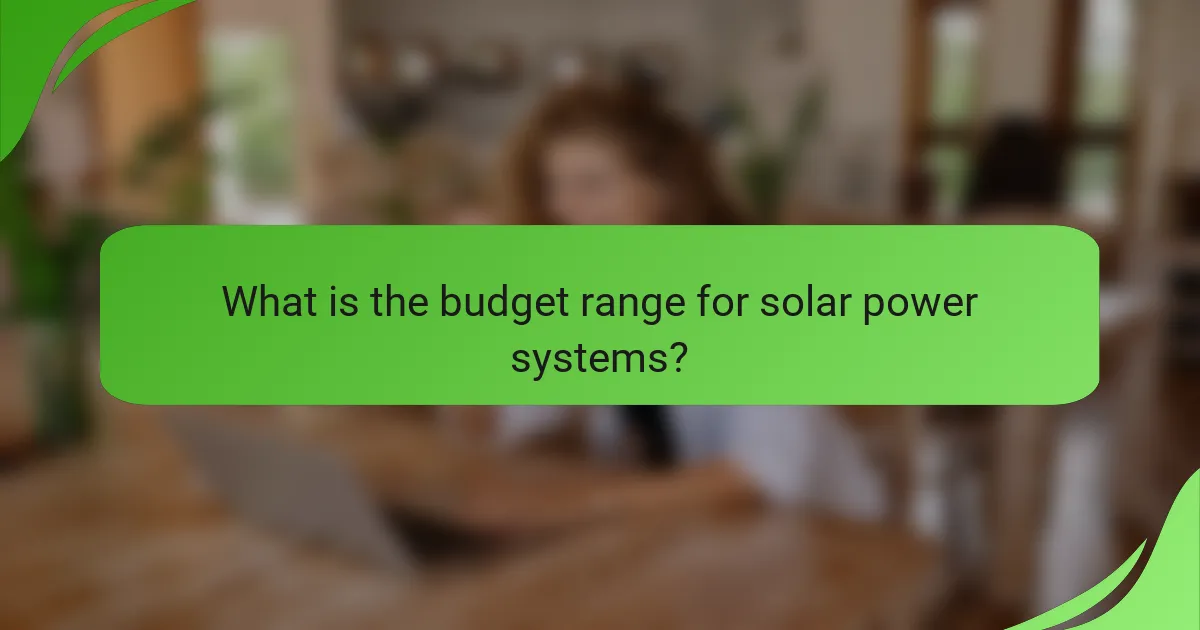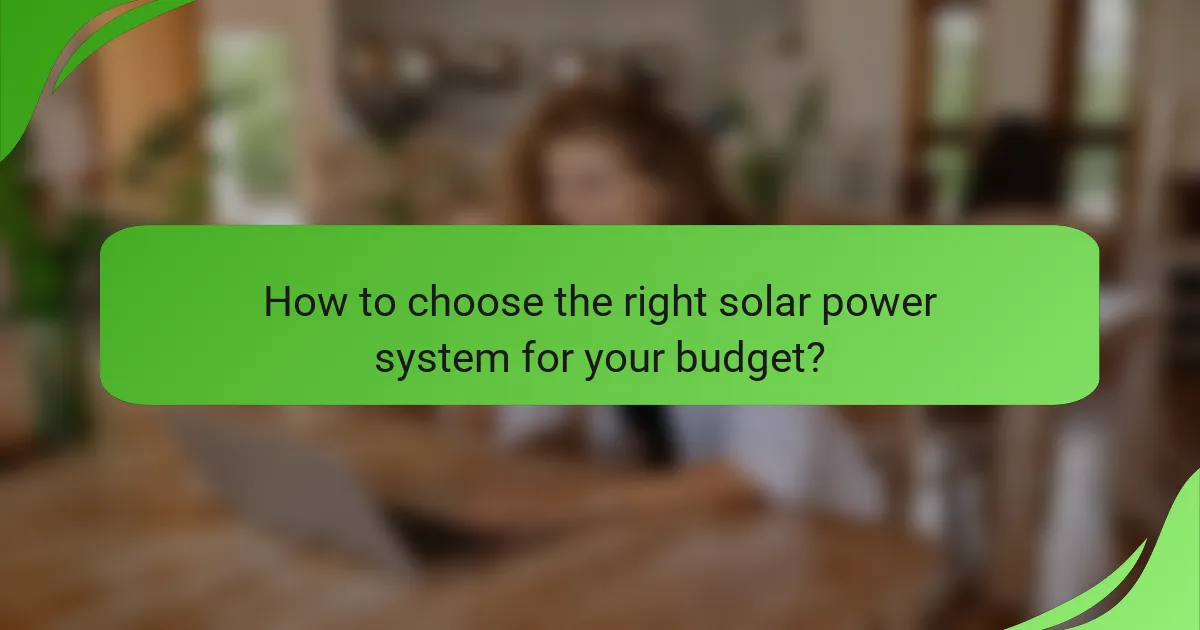Choosing the right solar power system involves understanding your energy needs, budget, and the various options available. With types ranging from monocrystalline to thin-film panels, each system offers distinct efficiencies and costs tailored to different homeowner requirements. By assessing your current energy consumption and future needs, you can make an informed decision that aligns with your financial plan and sustainability goals.

What are the best solar power systems for residential use?
The best solar power systems for residential use typically include monocrystalline, polycrystalline, thin-film panels, and hybrid systems. Each type has unique characteristics, efficiencies, and costs that cater to different homeowner needs and budgets.
Monocrystalline solar panels
Monocrystalline solar panels are known for their high efficiency and sleek appearance. Made from a single crystal structure, they typically offer efficiency rates between 15% and 22%, making them ideal for homeowners with limited roof space.
While they tend to be more expensive than other types, their longevity and performance in low-light conditions can justify the investment. Homeowners should consider their energy needs and budget when choosing these panels.
Polycrystalline solar panels
Polycrystalline solar panels are made from multiple crystal structures, which makes them less efficient than monocrystalline panels, usually ranging from 13% to 16%. However, they are generally more affordable, making them a popular choice for budget-conscious homeowners.
These panels perform well in sunny conditions but may have slightly lower performance in shaded areas. Homeowners should weigh the cost savings against the potential need for more panels to meet their energy requirements.
Thin-film solar panels
Thin-film solar panels are lightweight and flexible, making them suitable for various applications, including unconventional rooftops. Their efficiency typically ranges from 10% to 12%, which means they require more space to generate the same amount of power as crystalline panels.
While they are often the least expensive option, their lower efficiency and shorter lifespan can be drawbacks. Homeowners should assess their available space and energy needs before opting for thin-film technology.
Hybrid solar systems
Hybrid solar systems combine solar panels with battery storage, allowing homeowners to store excess energy for later use. This setup can enhance energy independence and reduce reliance on the grid, particularly during peak demand times.
While the initial investment is higher, the long-term savings on electricity bills and potential incentives can make hybrid systems an attractive option. Homeowners should evaluate their energy consumption patterns and local regulations regarding battery storage to determine if this system fits their needs.

How to assess your energy needs for solar power?
To effectively assess your energy needs for solar power, start by understanding your current energy consumption and considering any future changes. This assessment will guide you in selecting the right solar system size and type to meet your requirements.
Calculate your average energy consumption
Begin by reviewing your past electricity bills to determine your average monthly energy consumption, typically measured in kilowatt-hours (kWh). Most households consume between 500 to 1,500 kWh per month, depending on size and usage patterns.
To calculate your average, add up the total kWh from your bills over a year and divide by 12. This figure will help you estimate the solar power system capacity needed to offset your energy costs effectively.
Consider future energy needs
When assessing your energy needs, think about potential changes that could affect your consumption. For instance, if you plan to purchase electric vehicles or expand your home, your energy requirements may increase significantly.
It’s wise to factor in a growth margin of around 20-30% to accommodate these future needs. This foresight ensures that your solar system remains efficient and cost-effective as your energy demands evolve.

What is the budget range for solar power systems?
The budget for solar power systems typically ranges from several thousand to tens of thousands of dollars, depending on system size and installation specifics. Homeowners should expect to invest between $10,000 and $30,000 for a residential solar setup, factoring in installation and equipment costs.
Cost of installation
The cost of installation varies significantly based on system size, location, and installation complexity. On average, installation costs can range from $2.50 to $3.50 per watt, which means a typical 6 kW system might cost between $15,000 and $21,000 before any incentives.
When choosing a solar installer, consider obtaining multiple quotes and checking for certifications, such as those from the North American Board of Certified Energy Practitioners (NABCEP). This ensures quality workmanship and adherence to local regulations.
Long-term savings and incentives
Investing in solar power can lead to significant long-term savings on electricity bills, often reducing costs by 50% or more. Additionally, many regions offer incentives such as tax credits, rebates, and net metering, which can further offset initial expenses.
For example, the federal solar tax credit in the United States allows homeowners to deduct a percentage of the installation cost from their federal taxes. Research local incentives to maximize savings and ensure you take advantage of available programs.

How to choose the right solar power system for your budget?
Choosing the right solar power system for your budget involves assessing your financial capacity, energy needs, and available options. Start by determining how much you can invest upfront and what financing solutions are available to you.
Evaluate financing options
Financing options can significantly affect your solar power system choice. Common methods include cash purchases, solar loans, and leasing agreements. Each option has its pros and cons; for instance, cash purchases eliminate monthly payments but require a larger upfront investment.
Consider government incentives and tax credits, which can reduce overall costs. In the U.S., the federal solar tax credit allows you to deduct a percentage of the installation costs from your federal taxes, making solar more affordable.
Compare system costs and benefits
When comparing solar power systems, look at both installation costs and long-term savings. Typical residential solar systems in the U.S. can range from $15,000 to $30,000 before incentives, depending on size and efficiency. Assess the potential energy savings against these costs to determine your return on investment.
Evaluate the benefits of different system types, such as grid-tied versus off-grid systems. Grid-tied systems are generally less expensive and allow you to sell excess energy back to the grid, while off-grid systems provide energy independence but come with higher installation and maintenance costs.

What are the local regulations for solar power installation?
Local regulations for solar power installation vary significantly by region and often include requirements for permits, zoning laws, and incentives. Understanding these regulations is crucial for ensuring compliance and maximizing potential benefits.
Permits and zoning laws
Before installing a solar power system, you typically need to obtain the necessary permits from your local government. These permits ensure that your installation meets safety and building codes. Zoning laws may also dictate where solar panels can be placed, especially in residential areas.
Check with your local planning department to understand specific requirements, as they can vary widely. Some municipalities may have streamlined processes for solar installations, while others might impose stricter regulations that could delay your project.
Incentives and rebates in California
California offers various incentives and rebates to encourage solar power adoption. Programs such as the California Solar Initiative provide cash rebates based on the size of your solar system, while the federal solar tax credit allows you to deduct a significant percentage of your installation costs from your federal taxes.
Additionally, some utility companies in California offer performance-based incentives, which pay you based on the energy your solar system generates. Research these opportunities to determine which incentives you may qualify for, as they can significantly reduce your overall investment.

What are the maintenance requirements for solar power systems?
Solar power systems require minimal maintenance to operate efficiently, primarily involving regular cleaning and performance monitoring. Keeping the panels clean and ensuring the system functions correctly can significantly extend its lifespan and improve energy output.
Regular cleaning and inspections
Regular cleaning of solar panels is essential to remove dirt, dust, and debris that can block sunlight and reduce efficiency. Depending on your location, cleaning may be needed every few months to once a year. For instance, areas with heavy rainfall may require less frequent cleaning compared to dusty or arid regions.
Inspections should be conducted at least annually to check for any physical damage, loose connections, or signs of wear. This proactive approach can help identify issues early, preventing costly repairs down the line.
Monitoring system performance
Monitoring the performance of your solar power system is crucial to ensure it operates at peak efficiency. Many systems come with built-in monitoring tools that track energy production and alert you to any performance drops. Regularly reviewing this data can help you spot potential issues before they escalate.
Consider setting up alerts for significant drops in energy production, which may indicate a need for cleaning or repairs. Keeping an eye on performance metrics can help maintain optimal energy output and ensure that your investment continues to pay off.

How do solar batteries enhance solar power systems?
Solar batteries significantly improve solar power systems by storing excess energy generated during the day for use at night or during cloudy periods. This capability enhances energy independence and can lead to cost savings on electricity bills.
Benefits of integrating solar batteries
Integrating solar batteries into your solar power system offers several advantages. They allow for energy storage, which means you can utilize solar energy even when the sun isn’t shining. This leads to reduced reliance on the grid and can provide backup power during outages.
Additionally, solar batteries can help maximize the use of renewable energy, reducing your carbon footprint. By storing energy, you can avoid peak electricity rates and potentially lower your overall energy costs.
Considerations when choosing solar batteries
When selecting solar batteries, consider factors such as capacity, lifespan, and efficiency. Battery capacity, measured in kilowatt-hours (kWh), indicates how much energy can be stored. A typical home may require a battery with a capacity ranging from 5 kWh to 15 kWh, depending on energy consumption.
Lifespan is another critical factor; most lithium-ion batteries last between 10 to 15 years. Efficiency ratings show how much of the stored energy is usable, with higher percentages indicating better performance. Look for batteries with at least 80% efficiency.
Common types of solar batteries
The most common types of solar batteries are lead-acid, lithium-ion, and saltwater batteries. Lead-acid batteries are often less expensive but have shorter lifespans and lower efficiency. Lithium-ion batteries are more popular due to their longer lifespan and higher efficiency, making them a preferred choice for residential solar systems.
Saltwater batteries are an emerging option, known for being environmentally friendly and safe. However, they may not yet be as widely available or cost-effective as lithium-ion alternatives.
Installation and maintenance tips
Proper installation and maintenance are crucial for maximizing the performance of solar batteries. Ensure that your installation is performed by a qualified professional to comply with local regulations and safety standards. Regularly check battery health and connections to prevent issues.
It’s also wise to monitor battery performance through a dedicated app or monitoring system. This helps identify any potential problems early, ensuring your solar power system operates efficiently.
